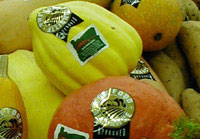Dear Umbra,
I try to buy organic food where possible, but I notice that there is often a tradeoff with other factors. For example, organic food has often been shipped further and/or is more heavily packaged. How do I assess those tradeoffs?
Ellen
Watertown, Mass.
Dearest Ellen,
As I’ve mentioned before, the USDA national organic standards came into effect last month, an event that has caused both rejoicing and concern in the organic community. The involvement of the feds in the organic movement reflects the strong market growth of the organic sector, which has been around 20 percent per year. This growth in turn reflects choices consumers are making toward food that tastes better, seems better for their health, eases burden on the environment, supports local farms, is safe for farm workers, etc., etc.; and choices farmers are making to move away from chemicals, monoculture, and animal confinement. Excellent trends that all conservationists should celebrate.

To market, to market …
Concern rises from the issues that you have noticed. The USDA sticker insures us against Thiabendazole and/or orthopenylphenol. It does not address farm size, shipping distances, fair prices for farmers or fair wages for workers, and has nothing to say about local economies. Although it addresses some of agriculture’s most grievous, polluting trends, organic does nothing, per se, to address the corporatization of agriculture or the disappearance of the family meal.
So, and I hope this doesn’t seem too strange, evaluating the tradeoffs may involve deciding that organic is not always the best choice. Think about your reasons for buying organic. What are you actually hoping for? It could be fewer externalized environmental costs such as shipping and packaging. It could be a vision of a nearby farm kept in business by your purchase. Perhaps you simply seek excellent flavor, better health, or a warm dinner table.

The Food Alliance label.
Photo: Food Alliance.
Like you, other organic proponents don’t just want chemical-free food, they want food to be grown with care on nearby mall-free land by people they meet at the farm stand. So, as the feds join the party, the party is moving on, and we’re seeing the rapid growth of creative marketing and farming niches. New non-governmental labels that further define food for consumers, often referred to as eco-labels, are part of the transformation of the organic movement from a movement defined by farming practices into one clarifying its focus on healthy farming systems and a healthy society. Eco-labels currently range from “locally grown in Western Massachusetts” to those put out by the Food Alliance, whose sustainability certification program includes farm-worker standards among its guidelines.
Although secondary labels add an excellent level of environmental and social information, they often still involve a middleperson. So if you’re looking to give most of your money to the actual farmer, seek out farmers’ markets in your area, or learn about community-supported agriculture (CSA), a direct marketing subscription service. Begin to eat foods that are seasonally appropriate for your climate, because bananas will always need to be shipped to Massachusetts (we hope). There are certainly folks near you, folks all over our fair nation, who are facilitating closer farm to shopper connections. If you have trouble finding any of these alternatives, call your state agriculture department, Cooperative Extension office, or health food store to ask them for leads.
Consumers are the most powerful agent of change in our current food system. Small and mid-size farmers won’t be able to stay in business unless they find a market, and there isn’t a market without the consumer. Demand the type of food you wish to eat. And in terms of the packaging — to avoid the extra plastic wrap, you may need to spend more time with a cookbook at the stove. This column has often reflected our overriding concern with the combustion engine; food decisions should have similar weight in our minds. Happily, concentrating on our gastronomic impact will only bring us joy. Taking the bus can feel like a chore even if we know it is a better choice. But buying food from a farmer you have actually met will be nothing but a pleasure, comparable to eating a type of apple you’ve never eaten before, an apple that tastes like a Robert Frost poem — once you have opened the door to these pleasures, you may never wish to shut it again.
Seriously,
Umbra


